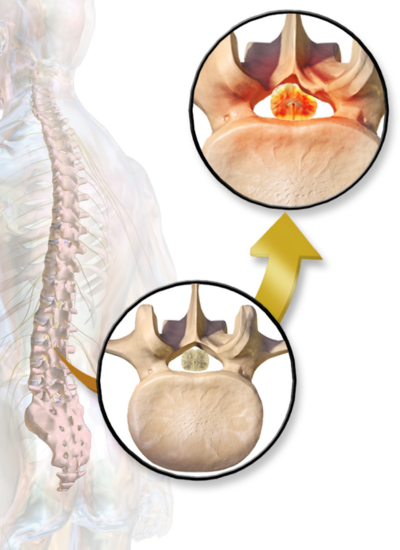Spinal stenosis
Key points about spinal stenosis
- Spinal stenosis is when the space inside your spinal canal (where your spinal cord is) becomes too small.
- This puts pressure on your spinal cord and nerves.
- It’s most likely to occur in your lower back or neck and can lead to pain, pins and needles or numbness.
- Mild stenosis can be treated with pain relief, activity and physiotherapy. Severe stenosis may need surgery.

Your spine is made up of a series of bones (vertebrae) that are stacked on top of each other from your tailbone (coccyx) to your skull, with soft cushions of gel-like tissue (discs) between them. There’s a hole in the middle of each vertebra and your spinal column runs through the opening, called the spinal canal. Nerves spread out from the spinal cord through spaces in the bone and travel to different points in your body.
Spinal stenosis is the narrowing of the space inside your backbone (spinal column). This can happen when either bone or something else presses on or constricts the spinal cord or nerve roots.

Image credit: Medical Gallery of Blausen Medical 2014(external link)
Spinal stenosis mainly occurs due to ageing and is most common over the age of 50 years. Age-related changes lead to narrowing of the spinal canal. For a small number of people, spinal stenosis may be present from birth.
Causes can include:
- Degenerative changes (eg, arthritis) leading to bony spurs in your spinal canal, or discs becoming damaged and squeezing out into the spinal canal. As you age the ligaments in your spine can become stiffer which can affect the spinal canal.
- Bone diseases, eg, Paget’s disease.
- Trauma or injuries to your spine.
- Tumours or growths growing inside your spinal canal.
All of the above can put pressure on your spinal cord, or the nerves extending from it, and cause spinal stenosis.
Many people with spinal stenosis don't have any symptoms. The location of your stenosis will affect your symptoms. Cervical stenosis occurs in your neck and lumbar stenosis in your lower back.
Symptoms of spinal stenosis in your neck can include:
- neck pain
- numbness or tingling that extends down your arms into your hands
- weakness in your fingers, hand or arm
- clumsiness of your hands.
Symptoms of spinal stenosis in your lower spine can include:
- back pain
- changes to your ability to walk
- pain going down your leg/s which gets worse when you move
- numbness, pins and needles, weakness or cramping in your leg/s
- urinary or bowel incontinence (loss of control)
- loss of sexual function or sensation.
Important
If you develop leg weakness, a floppy foot, difficulty walking or loss of bowel/bladder control, get immediate medical help.
Diagnosis
Your healthcare provider will talk to you about your symptoms and what makes them better or worse. You may have a physical examination and have imaging tests done. These could include an X-ray, CT scan or MRI.
Treatment
There’s no cure, but mild to moderate spinal stenosis can often be managed by yourself, with support from your healthcare team.
These things can help:
- Lumbar spinal stenosis may become worse when walking or standing for long periods. Changing your posture by sitting or bending forwards may help to reduce the pain or discomfort.
- Staying active.
- Losing weight if advised by your healthcare provider.
- Referral to a physiotherapist for exercises to help improve your flexibility, strength or balance.
- Medicines such as pain relief, anti-inflammatories, muscle relaxants or types of steroids may be used.
- Epidural steroid injections may be used for moderate spinal stenosis prior to considering surgery.
Severe symptoms
If you have really severe symptoms, surgery can be done to reduce the pressure on your spinal cord and nerves. However, it’s not always successful and will only be suggested if you can’t manage your symptoms in other ways. The most common approach is a decompression. Read more about lumbar decompression surgery(external link).
Apps reviewed by Healthify
You may find it useful to look at some Joint and bone health apps, Physiotherapy and exercise apps, and Pain management apps.
Spinal stenosis(external link) Tyneside Integrated Musculoskeletal Service (TIMS), NHS, UK (Includes exercises and video links)
Spinal stenosis(external link) Patient Info, UK
Apps
Joint and bone health apps
Physiotherapy and exercise apps
Pain management apps
References
- Spinal stenosis(external link) Tyneside Integrated Musculoskeletal Service (TIMS), NHS, UK, 2022
- Spinal stenosis(external link) American College of Rheumatology, US, 2023
- Spinal stenosis(external link) NIH, US, 2020
- Spinal stenosis(external link) Mayo Clinic, US, 2023
- Ho Lee B, Moon S-H, Suk K-S, et al. Lumbar spinal stenosis – pathophysiology and treatment principle: A narrative review(external link) Asian Spine J 2020;14(5):682-693
Credits: Healthify editorial team. Healthify is brought to you by Health Navigator Charitable Trust.
Reviewed by: Lizzy Guest, Academic Staff member in Health/Physiotherapist, Te Pukenga/Toi Ohomai.
Last reviewed:





